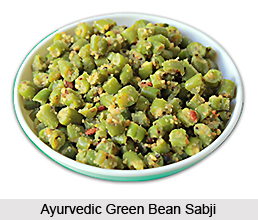 Ayurvedic green bean sabji is a healthy yet delicious recipe. This recipe is loaded with nutrition, vitamin and mineral. The basic ingredients for preparing this dish are green beans, shredded coconut, and safflower oil including some other ingredients. It can be easily cooked at home at any time. Ayurvedic green bean sabji can be eaten by pairing up with rice or roti.
Ayurvedic green bean sabji is a healthy yet delicious recipe. This recipe is loaded with nutrition, vitamin and mineral. The basic ingredients for preparing this dish are green beans, shredded coconut, and safflower oil including some other ingredients. It can be easily cooked at home at any time. Ayurvedic green bean sabji can be eaten by pairing up with rice or roti.
Ingredients of Ayurvedic Green Bean Sabji
•Two cloves of chopped garlic
•Four cups of chopped green beans
•One inch piece of fresh ginger peeled and finely chopped
•One tablespoon of shredded coconut
•Two tablespoon of chopped coriander
•Two tablespoon of safflower oil
•Half teaspoon of cumin seeds
•Half teaspoon of black mustard seeds
•One-fourth teaspoon of turmeric
•A pinch of hing
•Half an onion chopped
•Half teaspoon of masala powder
•Half teaspoon of salt
Method of Preparing Ayurvedic Green Bean Sabji
•Cut off the ends of the beans and slice on the diagonal into very small pieces, which is nearly one-fourth inch long.
•Wash the beans and peel the garlic, ginger, coconut, and coriander.
•With a little water, blend the garlic, ginger, coconut, and coriander. Keep it aside.
•Heat oil in a medium saucepan and add cumin seeds, mustard seeds and hing.
•When the seeds pop up, add the turmeric, masala powder and chopped onions. Stir until the onion softens and gets pink.
•Add the blended mixture, salt and green beans.
•Cover and simmer on low heat until it softens. This will take nearly two minutes and ayurvedic green bean sabji is more or less ready.
Benefits of Ayurvedic Green Bean Sabji
There are various health benefits of consuming ayurvedic green bean sabji. Some of the main benefits are as follows:
•The key ingredient of this recipe which is green bean is rich in fibre and low in calories.
•Ayurvedic green bean sabji is easy to digest.
•The preparation is a balance of vitamin and protein.
Caution about Ayurvedic Green Bean Sabji
Green beans are sweet, astringent and cooling. They can disturb the vata dosha if eaten in excess. They have a tendency to produce gas and constipation. Since it is prepared with hing and cumin seeds, it won`t affect the vata dosha. However, vata prakriti person should eat it carefully.




















